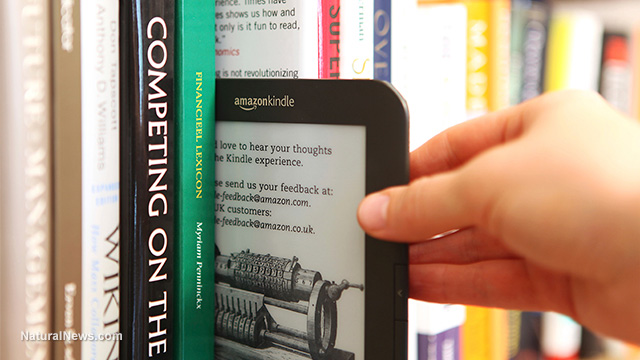When Amazon warehouse workers complained of sore feet from walking too much, the company simply replaced them with 30,000 robots (and counting)
Monday, February 01, 2016 by: David Gutierrez, staff writer
Tags: Amazon, robot workers, unemployment

(NaturalNews) Amazon.com's online sales empire is built on the ability to quickly deliver nearly any product straight to the customer's door. Increasingly, that speed is driven by automated systems, rather than human labor.
In 2012, the company purchased a robotics manufacturer named Kiva Systems for $775 million, and renamed it Amazon Robotics. In 2014, the company began using robots to do some of the merchandise selection and packaging at its warehouses. By the end of that year, there were 15,000 robots in use at 10 of Amazon's 50 fulfillment centers. That number had increased to 30,000 robots at 13 fulfillment centers by the third quarter of 2015.
"It's a bit of an investment that has implications for a lot of elements of our cost structure, but we're happy with Kiva," said Phil Hardin, Amazon's director of investor relations. "It has been a great innovation for us, and we think it makes the warehouse jobs better, and we think it makes our warehouses more productive."
Worker replacement imminent?
Perhaps by no coincidence, Amazon's acquisition of Kiva shortly followed a prominent September 2011 expose of working conditions in its warehouses, published in the Pennsylvania newspaper The Morning Call. The article recounted the plight of workers, many of them elderly, forced to walk 13 to 15 miles per day through poorly organized warehouses, trying to fill orders fast enough to meet a quota.When Amazon announced the deployment of its robots, it said that no workers would be fired as a consequence. Instead, the company said, the robots would work in conjunction with the employees, merely lightening employee workload. It remains to be seen how long the company will keep to that promise.
Regardless, Amazon has certainly achieved its goal of increased efficiency. A worker teamed up with a robot now fulfills orders three to four times as fast as a worker alone. Because the robots can navigate tight spaces, Amazon has increased the amount of inventory held at its mechanized warehouses by 50 percent.
Amazon to take over the skies, too?
So how exactly does a robot fill your Amazon order?Shelves in Amazon warehouses are still packed by human beings, but the packages are not shelved with any particular organizational system. Instead, the locations of various types of merchandise are computerized so that the robot can find it quickly.
The robot in question is about 16 inches tall, weighs nearly 320 pounds, and can move at 5 miles per hour. It can move about 700 pounds worth of items at one time, and uses a motion sensor to avoid both human and inanimate obstacles as it navigates the warehouse. When an order comes in, the robot retrieves the item from the shelf and transports it to a worker, who then packages it for shipment.
It's not just in packaging that Amazon is looking to remove the troublesome human element. The company has announced plans to launch a program called Amazon Prime Air, which will offer 30 minute delivery via drone. In this case, of course, there is no doubt that human workers are to be directly replaced.
According to an ad unveiled recently by the company, Prime Air will be available as an option when ordering from Amazon, and will be able to drop packages into spaces the size of a typical backyard. The current prototype has a range of only 15 miles, but the company has more ambitious plans.
"In time, there'll be a whole family of Amazon drones — different designs for different environments," says Jeremy Clarkson, the former host of BBC's Top Gear car show, in the ad.
Google and Walmart have also announced similar plans. Numerous legal hurdles need to be cleared, however, before any company can deploy a fleet of unmanned delivery drones.
Sources for this article include:
TechInsider.io
BusinessInsider.com
MCall.com
TheWire.com
Money.CNN.com
TechInsider.io
Amazon at FETCH.news
Get independent news alerts on natural cures, food lab tests, cannabis medicine, science, robotics, drones, privacy and more.
Take Action: Support Natural News by linking to this article from your website
Permalink to this article:
Embed article link: (copy HTML code below):
Reprinting this article:
Non-commercial use OK, cite NaturalNews.com with clickable link.
Follow Natural News on Facebook, Twitter, Google Plus, and Pinterest
- Newly released JFK files reveal Pentagon's role in creating Lyme disease and covid in the same lab
- Ginseng's hidden anti-aging power: How compound K is rewriting the rules of skincare
- “Endgame: The Hidden Agenda 21” unveils a world of conspiracy and control
- L.A.'s rebuilding nightmare: Only 4 permits issued after fire destroys 6,000 homes
- Scientists demand FDA withdraw mRNA COVID vaccines amid contamination and gene therapy concerns
- Senate Democrats deny censorship industrial complex existed, defend government's role in silencing dissent
- Dr. Suzanne Humphries makes bombshell appearance on Joe Rogan podcast, exposing vaccine industry deception back to POLIOMYELITIS
- “The shame of Minnesota”: Somali immigrants behind $250 million child nutrition fraud in largest COVID-era scam
- Former Congresswoman exposes CCP's deep infiltration of California through universities, ports, and fentanyl
- PROCESSED TABLE SALT in foods found to fuel depression
- Despite surge in MMR vaccination in Texas, measles outbreaks continue: Is VACCINE SHEDDING fueling the spread?
- “Independent” anti-Russia outlet MEDUZA faces COLLAPSE as US funding dries up
- Here are TEN all-natural ways to protect your garden without using harmful chemicals
- BPA: The hidden hormone disruptor sabotaging your health - and how to fight back
- Chewing gum's dirty secret: How your daily habit could be flooding your body with microplastics
- The hidden battle in your glass: How A1 and A2 milk could shape your health
- Catastrophic 7.7 earthquake devastates Myanmar and Thailand; death toll could reach 100,000
- Nomi Prins reveals how central bankers reshaped the global economy in “Collusion”
- Newly released JFK files reveal Pentagon's role in creating Lyme disease and covid in the same lab
- Analysis: The coming economic collapse, a mass uprising and Trump's three secret weapons to halt the growing revolt
- Festive flavors: The sweet history, nutritional profile and health benefits of pecan pie
- Elon Musk: Aliens could be here on Earth RIGHT NOW
- Trump reverses course on Gaza plan, says “nobody is expelling Palestinians”
- Big Pharma's $8 Billion bribery scheme exposed: how doctors are pushed to prescribe junk science, not heal
- Boys are back in town: Trump’s patriotic alpha crew takes the wheel while toxic females ride in the backseat
- Reclaim your health: How midlife exercise reverses years of inactivity
- A lack of integrity in Academia: Harvard professor found GUILTY of fraudulent research to promote CRT theory
- Survival 101: Effective EMF blocking techniques
- EPA advisor admits the agency is funneling billions to climate groups ahead of Trump’s return to White House
- Dr. Mike Yeadon releases 15-minute testimony - WATCH - about genocidal intent of COVID “vaccines”
- 5 Simple steps to boost your brainpower: How to strengthen executive function in a distracted world
- Florida takes a stand: DeSantis proposes permanent ban on mRNA vaccine mandates
- Sugarcane extract superior to cholesterol-lowering drugs?
- Mike Adams Sermon 66: God will DESTROY ISRAEL for its wickedness
- Pilots report mysterious lights 'moving at extreme speeds' across Oregon skies
- Space war brewing? Russia threatens to destroy Starlink satellites
- EPA advisor admits the agency is funneling billions to climate groups ahead of Trump’s return to White House
- California's social media censorship law struck down: A victory for free speech or a threat to online safety?
- The Health Ranger releases “Vaccine Zombie” song and music video, using AI-animated zombies for the music video
- Dr. Mike Yeadon releases 15-minute testimony - WATCH - about genocidal intent of COVID “vaccines”
- The pandemic as a tool for INDOCTRINATION: Understanding “The Indoctrinated Brain” by Dr. Michael Nehls
- Newly released JFK files reveal Pentagon's role in creating Lyme disease and covid in the same lab
- Florida takes a stand: DeSantis proposes permanent ban on mRNA vaccine mandates
- Mike Adams releases country western hit single: Goin’ Back in Time is Comin’ Home
- Mike Adams releases music poetry sensation: A Child of God
- “Why we influenced the 2020 elections”: Facebook files reveal the coordinated effort to bury the Hunter Biden laptop story
- Unpacking the Lies That We’ve Been Fed – new song and music video released by Mike Adams, the Health Ranger
- RFK Jr. clears key hurdle: Sen. Susan Collins backs controversial HHS nominee, signaling a new era for health policy
- Mike Adams releases new song and music video: Nothing More Disgusting Than a Globalist
- Michigan sheriff announces criminal investigation into 2020 election crimes, Dominion Voting Systems
- Israeli soldiers accused of even more torture and abuse in the West Bank
- Migrants are taking advantage of recent hurricanes to scam residents and loot their homes
- House Intelligence Committee calls for the ARREST and PROSECUTION of Dr. Anthony Fauci
- Rep. Nancy Mace introduces bill to ban biological males from female facilities on federal property
- Red Cross issues warning to stop blood plasma donations from vaccinated people
- Scientists confirm: GENIUS brain function can be spontaneously unleashed in humans without any apparent cause
- EPA advisor admits the agency is funneling billions to climate groups ahead of Trump’s return to White House
- HYSSOP: What research reveals about the health benefits of this ancient holy herb
- Two containers with completed ballots fall out of truck in Florida
- Fully vaccinated about to see “tsunami” of illness and death, warns virologist
- Global leaders unite to clamp down on “misinformation” with UN-backed Cascais Declaration
- BREAKING: 2025 NDAA authorizes mandatory military draft of WOMEN across America… as Pentagon pursues global NUCLEAR war with both Russia and China at the same time
- Michael Yon warns of a ZIONIST TAKEOVER in Trump’s second administration
- BOMBSHELL: DNA testing kits are a SCAM to develop ethnic-specific bioweapons
- Ozempic and Wegovy weight loss drugs are injectable LIZARD VENOM PEPTIDES that may unleash a devastating wave of organ failure… side effects align with symptoms of SNAKE BITES
- Israeli soldiers accused of even more torture and abuse in the West Bank
- These 13 countries just signed an agreement to engineer a global FAMINE by destroying food supply
- NASA admits that climate change occurs because of changes in Earth’s solar orbit, and NOT because of SUVs and fossil fuels
- RFK Jr. clears key hurdle: Sen. Susan Collins backs controversial HHS nominee, signaling a new era for health policy
- Sermon 30: How Jesus reveals Caesar’s FAKE CURRENCY and FALSE AUTHORITY
- Coriander seeds: Ancient medicine backed by modern science
- Arizona officials claim Maricopa County needs 10-13 days to tabulate results of the election
Science News & Studies
Medicine News and Information
Food News & Studies
Health News & Studies
Herbs News & Information
Pollution News & Studies
Cancer News & Studies
Climate News & Studies
Survival News & Information
Gear News & Information
News covering technology, stocks, hackers, and more



"Big Tech and mainstream media are constantly trying to silence the independent voices that dare to bring you the truth about toxic food ingredients, dangerous medications and the failed, fraudulent science of the profit-driven medical establishment.
Email is one of the best ways to make sure you stay informed, without the censorship of the tech giants (Google, Apple, Facebook, Twitter, YouTube, etc.). Stay informed and you'll even likely learn information that may help save your own life."
–The Health Ranger, Mike Adams












































